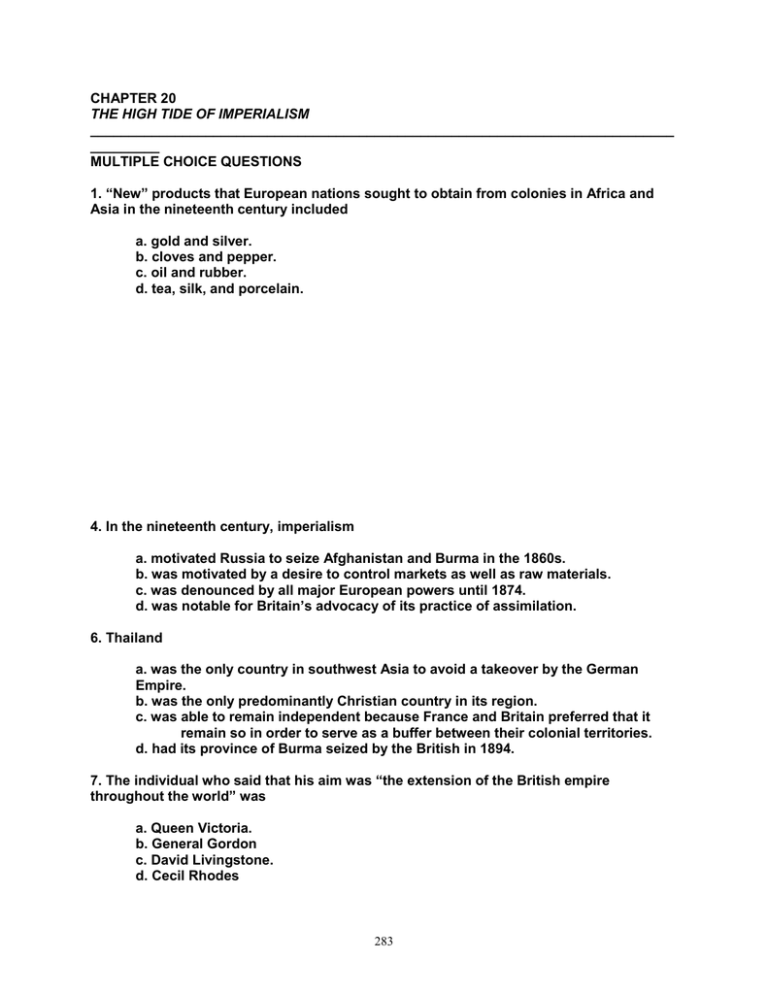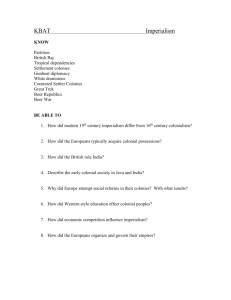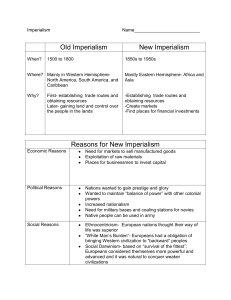chapter 20 - Lone Star College System
advertisement

CHAPTER 20 THE HIGH TIDE OF IMPERIALISM ____________________________________________________________________________ _________ MULTIPLE CHOICE QUESTIONS 1. “New” products that European nations sought to obtain from colonies in Africa and Asia in the nineteenth century included a. gold and silver. b. cloves and pepper. c. oil and rubber. d. tea, silk, and porcelain. 4. In the nineteenth century, imperialism a. motivated Russia to seize Afghanistan and Burma in the 1860s. b. was motivated by a desire to control markets as well as raw materials. c. was denounced by all major European powers until 1874. d. was notable for Britain’s advocacy of its practice of assimilation. 6. Thailand a. was the only country in southwest Asia to avoid a takeover by the German Empire. b. was the only predominantly Christian country in its region. c. was able to remain independent because France and Britain preferred that it remain so in order to serve as a buffer between their colonial territories. d. had its province of Burma seized by the British in 1894. 7. The individual who said that his aim was “the extension of the British empire throughout the world” was a. Queen Victoria. b. General Gordon c. David Livingstone. d. Cecil Rhodes 283 8. Remote location and mountainous terrain spared which of the following from colonial rule? a. Ethiopia. b. Afghanistan. c. Japan. d. both a and b 10. Which of the following is not a true statement about nineteenth-century Western expansion in Southeast Asia? a. Sir Stamford Raffles established Singapore in 1819. b. Burma retained its independence. c. The French forcibly created their Indochinese Union. d. Thailand remained independent, as a result of mutual British and French interests. 12. The Philippine guerrilla leader who failed to thwart the United States conquest was a. Antonio Celino. b. Antonio Barbosa. c. Emilio Aguinaldo. d. Ferdinand Marcos. 14. Muhammad Ali a. was a native-born Egyptian who came to rule his homeland. b. modernized Egypt and extended its hegemony over neighboring regions. c. overthrew the Ottoman power in the Middle East. d. reaped great rewards from the construction of the Suez Canal. 15. In the second half of the nineteenth century a. a Frenchman built the Suez Canal, but it ultimately came under British control. b. British General Charles Gordon restored Egyptian rule in Sudan with his SikhGurkha army. c. Tunisia came under the total domination of Berber rebels. d. the Turks took control of Tripoli from the Italians. 16. All of the following statements about Zanzibar are true except that it was a. the first capital of South Africa after the Boer War. b. the location of substantial clove plantations. c. the main African port in the early nineteenth century. d. the African capital of the Sultan of Oman. 284 20. The Great Trek a. was ordered by the French government. b. took place before the Boers encountered the Zulus. c. was a Zulu march led by their ruler named Shaka. d. was the northeastward advance of the Boers after the British take-over of the Cape Colony. 21. In southern Africa during the 1800s a. the French established an impregnable fortress at Zanzibar. b. Belgian troops were driven out of the Cape area after they had tried to force the Boers to speak only French. c. the racially tolerant Boers were able to organize a biracial, intertribal force which successfully resisted the British army for three years. d. the British were able to use the Boers’ Great Trek to increase their imperial territory far inland from the coastal areas at Capetown. 23. The upper Nile was the area of two major confrontations in the late 1800s between the British and the a. French at Cairo and the Italians at Fashoda. b. Mahdi at Khartoum and the French at Fashoda. c. Italians at Alexandria and the Turks at Cairo. d. Turks at Crete and the Germans at Khartoum. 24. Which of the following pairs, naming the European power and its African holding, is not correct? a. Germany – Congo b. Italy – Libya c. Belgium – Congo d. France – Madagascar 27. The missionary who urged Europeans to introduce the “three Cs” (Christianity, commerce and civilization) was a. Eleazir Thornton. b. Willson Wallace. c. Thomas Stanley. d. David Livingstone. 28. Quinine was used by Europeans to provide partial immunity from a. sleeping sickness. b. diphtheria. c. scurvy. d. malaria. 285 29. The Berlin Conference of 1884 a. settled the Boer War. b. established guidelines to ease the frictions created by different European nations’ efforts to gain control of Africa. c. led to a large-scale German attack on British colonial property in Kenya. d. devised a system for collaborative missionary activity in Africa. 31. British colonial policies a. were based on assimilation, or direct rule, in Nigeria. b. included the policy of assimilation in Singapore, India and Nigeria. c. opposed the development of concentration camps to end guerrilla resistance in the Boer War. d. helped to end the slave trade in Africa and thuggee and sati in India. 32. In the political realm, ultimate control of European colonies in Asia and Africa was a. primarily relegated to local authorities. b. maintained by force of arms. c. totally devoid of any democracy, except for urban groups. d. provided for by educational opportunity enhancements. 33. The major economic objective of the “civilizing mission” was to a. reduce the numbers of the colonies’ urban populations. b. ensure competitive factors. c. develop internal native production profits. d. integrate native societies into the global economic market. 35. Generally speaking, European colonialism was a. a process that aimed to help the colonial peoples as much as possible. b. largely exploitation, usually accompanied by condescension. c. implemented in a fashion that enabled all involved to reap the most benefit possible. d. an effort to produce mutual growth and development. 36. The British Raj a. brought even greater disorder and inefficiency in Indian governmental administration. b. enacted a homestead decree which gave all Indian peasants approximately fifty-five acres for each family to cultivate as its own, private property. c. established a new school system to educate the children of the elite. d. quickly allowed native Indians to join the highest levels of the colonial administration. 286 38. Which of the following cities became a major colonial manufacturing center? a. Luxor b. Timbuktu c. Ulan Bator d. Batavia 39. In Southeast Asia, imperialist governments a. fostered intensive industrial development and were widely successful, as rural peasant percentages had dropped below fifty in Vietnam and Java by 1905. b. established mass educational systems to educate peasant children for citizenship and industrial work. c. often blended direct and indirect rule. d. contracted with private Asia conglomerates to administer their colonies. 40. Which of the following can be said to be a benefit of colonialism in Southeast Asia? a. The creation of high-wage manufacturing centers. b. Economic exploitation of native workers. c. The beginnings of a modern economic infrastructure. d. The creation of universal peasant landownership. 42. By combining the old Cape Colony and Natal with the Boer Republics in 1910, the British created the a. Zambezi Federation. b. Union of East Africa. c. Union of North Africa. d. Union of South Africa. 43. Colonial policies reflecting a relative lack of racist attitudes, and the revolutionary belief in the universality of human nature, were practiced by a. the United States. b. England. c. France. d. Germany. 44. It can be said that the first stage in the development of modern nationalism is a. the collapse of all tribal loyalties. b. the complete assimilation of the ruling elite into the colonial infrastructure. c. the breakdown of village hierarchical structures. d. resistance to colonial conquest, often based on traditional cultural factors. 287 45. Ran Mohan Roy’s major motivation in creating the Brahmo Samaj was to a. provide Hinduism with protection against verbal attacks by British colonialists. b. supply Indian revolutionaries with arms. c. prevent the British from controlling India. d. find a method for successful revolt against British rule in India. 47. The Sepoy Mutiny was caused by a. the traditional hostility between Muslims and the Buddhist majority. b. British tax policies in India. c. British racial policies in India. d. animal fat and lard that was on the rifle cartridges used by the Sepoy troops, which upset both Hindu and Muslim soldiers. 48. In assessing the impact of nineteenth-century imperialism, it can accurately be said that a. the consequences of imperialism are more complex than was earlier believed. b. the one certain conclusion which can be reached is that it was uniformly advantageous for all, bringing permanent advantages which still persist. c. when conflicts of interest rose, they were invariably settled in favor of the the colonies. d. it proved particularly beneficial to the societies of East Asia, which were given special economic help and cultural support by their colonial overlords. 50. On balance, one can accurately say that all of the following are correct except a. European imperialism in East Asia was more profitable than imperialism in Africa. b. Britain established a protectorate over warring ethnic groups in Niger delta. c. converting ocean vessels from wind to steam power enhanced the importance colonies. d. Europeans left no legacy of any sort in their colonies 288





